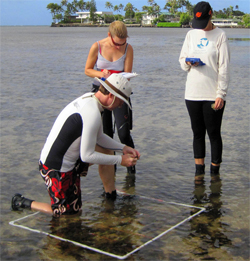Participatory Monitoring

Community members conduct monitoring activities monthly in Maunalua Bay. Photo © TNC
Monitoring programs traditionally use expert, researcher or manager observers and may be resource-intensive. Therefore, monitoring programs typically are unable to provide detailed information across broad spatial and temporal scales. By establishing participatory monitoring programs, managers have access to more information from more sites on a more regular basis.
Participatory monitoring programs involve non-expert observers – sometimes called ‘citizen scientists’ – in monitoring activities. These monitoring activities may be led by scientists or managers or have observers monitoring reefs independently. Coral reef managers often use participatory monitoring programs to assess reef condition, disturbance detection, impact assessment following disturbances, and assessments of the effectiveness of management actions.
Benefits of Participatory Monitoring
Managers have received great benefits from engaging reef users and stakeholders to assist with disturbance detection and impact assessment. These include:
- Reef users regularly visiting reef sites can help to detect impacts when they occur, forming an ‘early warning system’ for managers. This is particularly important because routine monitoring may miss reef impacts since corals are usually stressed only for a period of time and dead corals are quickly colonized by algae.
- Including reef users and stakeholders in impact assessment may also result in valuable education, outreach and awareness-raising. For example, tourism operators may raise awareness of climate change impacts on coral reefs through participatory monitoring programs that engage reef users such as scuba divers.
- Including community members and stakeholders in monitoring activities may build support for actions taken to support reef recovery. Such actions include limiting access or activities to severely affected areas in the case of a disturbance.
- The two-way exchange of information between managers and participants increases the capacity to manage reefs adaptively, meets education and outreach objectives, and can increase stewardship.
How to Establish a Participatory Monitoring Network
Establishing a participatory monitoring network requires: 1) identifying observers, 2) developing survey methods, 3) training observers, 4) creating a system or process by which data is transferred from the observers to the managers, and 5) reporting back to observers to reinforce participation.
Managers may decide to either establish a participatory monitoring network or may make routine and responsive monitoring programs participatory by including community members and reef stakeholders when surveys are conducted. Participant observers may be identified by determining which reef users and stakeholders visit reefs regularly and are most likely to be able to participate and benefit.
Survey methods need to be rapid assessments that take account of participants time availability and will be constrained to the skill level participants may acquire during the training program. Training programs may be tailored based on resource availability and to ensure participants gain the right skills and become sufficiently proficient with those skills to make reliable observations.
It is important to tailor the investment in participatory monitoring to existing resources and to meet the most critical information needs that directly support management decisions. Recent research indicates that data from participatory monitoring programs is often translated into management actions more readily and rapidly than data from professional monitoring schemes that require expert observers. ref
Examples of Participatory Reef Monitoring Programs
Great Barrier Reef Eye on the Reef Program
